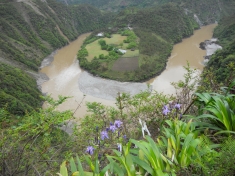Day of Action Defending World Heritage Rivers
As I write this, our offices are abuzz with plans for March 14, the International Day of Action for Rivers. This will be the seventeenth year of the event; International Rivers was there when the idea arose from the first meeting of dam-affected peoples in Curitiba, Brazil, and we’ve been celebrating and activating ever since. It’s one of the best pleasures to be a part of the amazing international movement of river activists.
Once again, we anticipate hundreds of demonstrations, vigils, workshops and celebrations as people from more than 40 countries creatively and courageously take a stand for free-flowing rivers. This year, in recognition of the power and success of civil society advocates, we’re organizing under the mantra The World’s Rivers are in Our Hands.
This year a number of actions seek to unite our movements across watersheds and political boundaries. There’s no single nefarious force to identify and target that will take the big-dam pressure off our rivers, yet there is a common line of values that the dam industry and governments seem willing to cross, and that we river people must defend: river systems of universal and outstanding global significance.
Governments the world over have taken legal measures to protect particularly unique and valuable natural and cultural treasures in perpetuity. The establishment of national parks is one mechanism that has resulted in an estimated 6,500 protected areas in countries across the globe. Yet even these protected areas face destructive large dams. With more than 500 dams now planned in the Balkans, for example, our friends at River Watch are organizing to “Save the Blue Heart of Europe” against dams planned in national parks in Albania, Macedonia and Slovakia. The question has been posed: If we can’t stop destructive dams in our national parks, then where can we draw the line?
International Rivers will be taking action on March 14 to profile the threats to rivers and related ecosystems that are designated UNESCO World Heritage Sites. Of the nearly 1,000 sites of “outstanding universal value” in the World Heritage system, several are directly threatened by large hydropower projects.
The World Heritage Committee meets annually to, among other business, review and consider sites to include on its “In Danger” list, a designation that aims to mobilize attention and resources to address imminent threats. International Rivers has provided evidence to the Committee, comprised of 21 member-states, on threats to river-dependent World Heritage Sites. Two sites under clear and immediate threat in 2014 are the Three Parallel Rivers in China and the Lake Turkana Basin in East Africa.
Three Parallel Rivers is a 17,000-square-kilometer site featuring upper reaches of the Yangtze (Jinsha), the Mekong (Lancang) and Salween (Nu) rivers, which run roughly parallel in deep gorges along 300 km. Inscribed as a World Heritage Site in 2003, the area is considered one of the richest temperate regions in the world for biodiversity and today is still a relatively undisturbed ecological zone. China has revived plans to build up to 13 dams on the Nu River, which would significantly change the scenic and ecological value of this World Heritage Site. The Committee has requested that China update the site’s status for review at its 2015 meeting.
Kenya’s Lake Turkana is the largest desert lake in the world. Inscribed in 1997, this World Heritage Site has supported hominids for two million years, and is today the life-source for a quarter million people, abundant crocodiles and fish, and some 350 species of birds. Ethiopia is poised to begin filling the Gibe III Dam on the Omo River – the source for this lake – with potentially disastrous hydrological consequences for Lake Turkana.
This year I’ll be joining in a Day of Action for Rivers that will send a message to World Heritage Committee members in time for their June meeting in Qatar: Alert the world to the risks these sites face, and grant them World Heritage “In Danger” status. If you aren’t already joining an action on March 14, then consider organizing embassy and consulate visits in your own metropolitan area. Visit our website to get a list of the 21 voting nations on the World Heritage Committee and briefing kits for the full range of activities for the International Day of Action for Rivers.
Whether you pump your fist in the air, bring your hands together in prayer, or go knocking on consular doors, do find a way to join into the International Day of Action for Rivers on March 14. The fate of the world’s rivers are in our hands!



